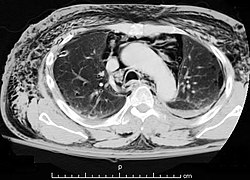Pneumomediastinum

Editor-In-Chief: Prab R Tumpati, MD
Obesity, Sleep & Internal medicine
Founder, WikiMD Wellnesspedia &
W8MD medical weight loss NYC and sleep center NYC
| Pneumomediastinum | |
|---|---|

| |
| Synonyms | Mediastinal emphysema |
| Pronounce | |
| Specialty | Pulmonology, Emergency medicine |
| Symptoms | Chest pain, shortness of breath, neck pain, cough |
| Complications | Pneumothorax, subcutaneous emphysema |
| Onset | Sudden |
| Duration | Variable |
| Types | N/A |
| Causes | Trauma, asthma, vomiting, esophageal rupture |
| Risks | Smoking, asthma, respiratory infections |
| Diagnosis | Chest X-ray, CT scan |
| Differential diagnosis | Pneumothorax, pericarditis, myocardial infarction |
| Prevention | N/A |
| Treatment | Oxygen therapy, analgesics, rest |
| Medication | Pain relievers |
| Prognosis | Generally good with treatment |
| Frequency | Rare |
| Deaths | N/A |


File:UOTW 67 - Ultrasound of the Week 1.webm Pneumomediastinum (PM) is a medical condition characterized by the presence of air or gas in the mediastinum, the central compartment of the thoracic cavity. It is a rare condition that can occur due to a variety of causes, including trauma, disease, or spontaneously.
Causes[edit]
The causes of pneumomediastinum can be broadly classified into two categories: spontaneous and secondary. Spontaneous pneumomediastinum (SPM) occurs without any apparent cause or precipitating factor. It is often associated with activities that cause a sudden increase in intrathoracic pressure, such as coughing, vomiting, childbirth, or weightlifting. Secondary pneumomediastinum occurs as a result of trauma or disease. This can include chest trauma, lung disease, or invasive procedures involving the chest or abdomen.
Symptoms[edit]
The symptoms of pneumomediastinum can vary depending on the severity of the condition. Common symptoms include chest pain, shortness of breath, and a feeling of tightness in the chest. Other symptoms can include neck pain, difficulty swallowing, and changes in voice.
Diagnosis[edit]
The diagnosis of pneumomediastinum is typically made through imaging studies. A chest X-ray is often the first test performed, and can show air in the mediastinum. A computed tomography (CT) scan of the chest can provide more detailed information and help to identify the cause of the pneumomediastinum.
Treatment[edit]
The treatment of pneumomediastinum depends on the underlying cause and the severity of the condition. In many cases, no specific treatment is needed and the condition will resolve on its own. In more severe cases, treatment may include oxygen therapy, pain management, and in some cases, surgery.
See also[edit]
Ad. Transform your life with W8MD's Budget GLP-1 injections from $75


W8MD offers a medical weight loss program to lose weight in Philadelphia. Our physician-supervised medical weight loss provides:
- Weight loss injections in NYC (generic and brand names):
- Zepbound / Mounjaro, Wegovy / Ozempic, Saxenda
- Most insurances accepted or discounted self-pay rates. We will obtain insurance prior authorizations if needed.
- Generic GLP1 weight loss injections from $75 for the starting dose.
- Also offer prescription weight loss medications including Phentermine, Qsymia, Diethylpropion, Contrave etc.
NYC weight loss doctor appointmentsNYC weight loss doctor appointments
Start your NYC weight loss journey today at our NYC medical weight loss and Philadelphia medical weight loss clinics.
- Call 718-946-5500 to lose weight in NYC or for medical weight loss in Philadelphia 215-676-2334.
- Tags:NYC medical weight loss, Philadelphia lose weight Zepbound NYC, Budget GLP1 weight loss injections, Wegovy Philadelphia, Wegovy NYC, Philadelphia medical weight loss, Brookly weight loss and Wegovy NYC
|
WikiMD's Wellness Encyclopedia |
| Let Food Be Thy Medicine Medicine Thy Food - Hippocrates |
Medical Disclaimer: WikiMD is not a substitute for professional medical advice. The information on WikiMD is provided as an information resource only, may be incorrect, outdated or misleading, and is not to be used or relied on for any diagnostic or treatment purposes. Please consult your health care provider before making any healthcare decisions or for guidance about a specific medical condition. WikiMD expressly disclaims responsibility, and shall have no liability, for any damages, loss, injury, or liability whatsoever suffered as a result of your reliance on the information contained in this site. By visiting this site you agree to the foregoing terms and conditions, which may from time to time be changed or supplemented by WikiMD. If you do not agree to the foregoing terms and conditions, you should not enter or use this site. See full disclaimer.
Credits:Most images are courtesy of Wikimedia commons, and templates, categories Wikipedia, licensed under CC BY SA or similar.
Translate this page: - East Asian
中文,
日本,
한국어,
South Asian
हिन्दी,
தமிழ்,
తెలుగు,
Urdu,
ಕನ್ನಡ,
Southeast Asian
Indonesian,
Vietnamese,
Thai,
မြန်မာဘာသာ,
বাংলা
European
español,
Deutsch,
français,
Greek,
português do Brasil,
polski,
română,
русский,
Nederlands,
norsk,
svenska,
suomi,
Italian
Middle Eastern & African
عربى,
Turkish,
Persian,
Hebrew,
Afrikaans,
isiZulu,
Kiswahili,
Other
Bulgarian,
Hungarian,
Czech,
Swedish,
മലയാളം,
मराठी,
ਪੰਜਾਬੀ,
ગુજરાતી,
Portuguese,
Ukrainian


